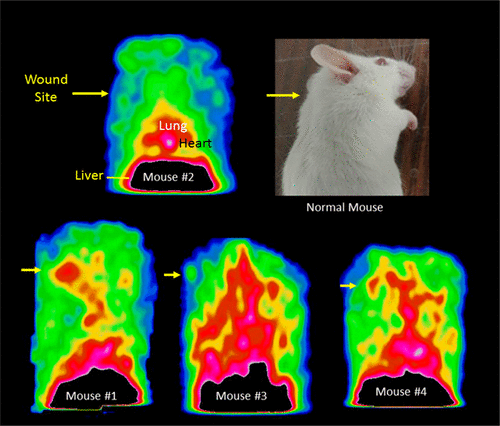当前位置:
X-MOL 学术
›
Bioconjugate Chem.
›
论文详情
Our official English website, www.x-mol.net, welcomes your
feedback! (Note: you will need to create a separate account there.)
Preparation of Tc99m-Labeled Pseudomonas Bacteriophage without Adversely Impacting Infectivity or Biodistribution
Bioconjugate Chemistry ( IF 4.0 ) Pub Date : 2017-10-26 00:00:00 , DOI: 10.1021/acs.bioconjchem.7b00395 Derek Holman 1 , Matthew P. Lungren 2 , Jonathan Hardy 3 , Chris Contag 1, 2, 3 , Francis Blankenberg 2
Bioconjugate Chemistry ( IF 4.0 ) Pub Date : 2017-10-26 00:00:00 , DOI: 10.1021/acs.bioconjchem.7b00395 Derek Holman 1 , Matthew P. Lungren 2 , Jonathan Hardy 3 , Chris Contag 1, 2, 3 , Francis Blankenberg 2
Affiliation

|
Bacteriophages (phages) are ubiquitous viruses which have adapted to infect and replicate within target bacteria, their only known hosts, in a strain specific fashion with minimal cross infectivity. The recent steep rise in antibiotic resistance throughout the world has renewed interest in adapting phages for the imaging and treatment of bacterial infection in humans. In this article, we describe the current limitations surrounding the radiolabeling of phage for the imaging and treatment of bacterial infection and methods to overcome these difficulties. Specifically, we examined the effects of hydrazinonicotinamide conjugation and removal of bacterial DNA on the infectivity, biodistribution, and radionuclide imaging of a phage lytic for a clinically relevant strain of Pseudomonas aeruginosa, a common Gram-negative bacterial pathogen often resistant to multiple antibiotics. We found that all but the briefest reaction of concentrated phage with hydrazinonicotinamide (≤3 min) resulted in nearly complete loss of infectivity. Furthermore, we determined that digestion and removal of bacterial DNA was needed to avoid high nonspecific uptake of hydrazinonicotinamide-labeled phage within the liver and spleen as well as prolonged circulation in the blood. We also demonstrate the surprisingly wide soft tissue and organ biodistribution and rapid pharmacokinetics of 99mTc-hydrazinonicotinamide-labeled phage in normal mice as well as its imaging characteristics and efficacy in wounded mice infected with bioluminescent Pseudomonas aeruginosa. In conclusion, the preservation of phage infectivity and removal of all bacterial containments including DNA are critical methodologic considerations in the labeling of phages for imaging and therapy.
中文翻译:

Tc99m标签的假单胞菌噬菌体的制备,而不会不利地影响传染性或生物分布。
噬菌体(噬菌体)是普遍存在的病毒,已经适应了它们以唯一的菌株形式,以最小的交叉感染性感染并在靶细菌(它们唯一的已知宿主)内复制。最近全世界抗生素耐药性的急剧上升,重新引起了人们对使噬菌体适应人类细菌感染的成像和治疗的兴趣。在本文中,我们描述了用于细菌感染的成像和治疗的噬菌体放射性标记目前的局限性以及克服这些困难的方法。具体而言,我们检查了肼基烟酰胺共轭和细菌DNA的去除对铜绿假单胞菌临床相关菌株的噬菌体裂解物的感染性,生物分布和放射性核素成像的影响。,一种常见的革兰氏阴性细菌病原体,通常对多种抗生素具有抗性。我们发现,除了最短的浓缩噬菌体与肼基烟酰胺反应(≤3分钟)以外,其他所有反应几乎都导致感染力完全丧失。此外,我们确定需要消化和去除细菌DNA,以避免在肝和脾脏中高度非特异性摄取hydrazinonicotinamide标记的噬菌体以及延长血液循环。我们还证明了正常小鼠中99m Tc-肼基异烟酰胺酰胺标记的噬菌体的软组织和器官的生物分布范围惊人且快速,其药代动力学及其在感染了生物发光铜绿假单胞菌的受伤小鼠中的成像特征和功效。总之,在噬菌体的成像和治疗标签中,保持噬菌体传染性和去除所有细菌包容(包括DNA)是方法学上的关键考虑因素。
更新日期:2017-10-27
中文翻译:

Tc99m标签的假单胞菌噬菌体的制备,而不会不利地影响传染性或生物分布。
噬菌体(噬菌体)是普遍存在的病毒,已经适应了它们以唯一的菌株形式,以最小的交叉感染性感染并在靶细菌(它们唯一的已知宿主)内复制。最近全世界抗生素耐药性的急剧上升,重新引起了人们对使噬菌体适应人类细菌感染的成像和治疗的兴趣。在本文中,我们描述了用于细菌感染的成像和治疗的噬菌体放射性标记目前的局限性以及克服这些困难的方法。具体而言,我们检查了肼基烟酰胺共轭和细菌DNA的去除对铜绿假单胞菌临床相关菌株的噬菌体裂解物的感染性,生物分布和放射性核素成像的影响。,一种常见的革兰氏阴性细菌病原体,通常对多种抗生素具有抗性。我们发现,除了最短的浓缩噬菌体与肼基烟酰胺反应(≤3分钟)以外,其他所有反应几乎都导致感染力完全丧失。此外,我们确定需要消化和去除细菌DNA,以避免在肝和脾脏中高度非特异性摄取hydrazinonicotinamide标记的噬菌体以及延长血液循环。我们还证明了正常小鼠中99m Tc-肼基异烟酰胺酰胺标记的噬菌体的软组织和器官的生物分布范围惊人且快速,其药代动力学及其在感染了生物发光铜绿假单胞菌的受伤小鼠中的成像特征和功效。总之,在噬菌体的成像和治疗标签中,保持噬菌体传染性和去除所有细菌包容(包括DNA)是方法学上的关键考虑因素。











































 京公网安备 11010802027423号
京公网安备 11010802027423号